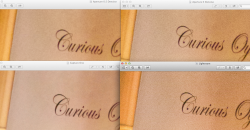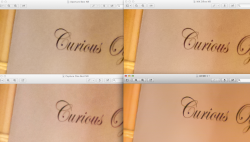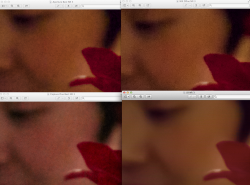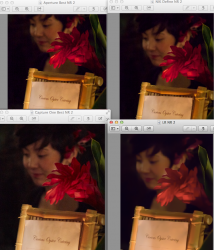I spent some time this evening downloading Lightroom 4.3 and Capture One Pro 7 to compare their image adjustment capabilities to Aperture. I worked with a couple different Canon 5D Mark III RAW files almost exclusively at 100%. Here are my observations.
(It's late and I want to get this posted, but if there's interest, I'll post some comparison 100% crops to support some of my comments later this week).
RAW conversion:
Sharpness and Noise: Without making any adjustments, Capture One clearly has a better set of RAW conversion settings for the Canon 5D3 than either Apple or Adobe. The images have less noise and are sharper right out of the gate. While this is easily compensated for in both Aperture and Adobe, Capture One could save a bit of time when working on lots of images.
Saturation and Tone: Aperture files are bit more saturated than either of the other two. I was able to get Aperture's saturation to match the other two by pulling it back a couple of notches on the slider. So again, you can easily adjust this to taste in all three RAW converters. All three programs offer ever so slightly different tonal characteristics.
Basic Adjustments:
Histogram: Since the Histogram is the key tool I like to monitor when tweaking my images, I found the histogram display in Aperture to be the most helpful in that it is wide and appears to show blown highlights and crushed shadows a little better than the other two.
Lifting Shadows: Capture One rules here. It’s shadow slider does an amazing job of lifting the shadows with less noise, more contrast, and better saturation than the other two programs. In Aperture and Lightroom I needed to use both the shadow recovery slider and black adjustment slider to get similar results to Capture One. In addition both needed a bit of extra noise reduction and saturation to match Capture One. Again it seems Capture One makes things faster. While a lot of people say Lightroom has much better shadow recovery, I didn’t find this at all. It actually seems remarkably similar in what can be accomplished. Aperture’s shadow slider seems to offer more latitude but it’s less useful on the extreme because the loss of contrast is so great. It’s good up to it’s mid point which is about the same as Lightroom at 100. Then you need to finesse either program further with the blacks adjustment.
Noise Reduction (on low ISO images): I didn’t need to play with this on Capture One. It’s default noise reduction seems fantastic. Lightroom does have a lot more capability here than Aperture, but to be honest, for the images I was working on (shadow noise at low ISO) where a Luminance NR setting in LR of 25 was good, I could get Aperture NR to look similar with the RAW De-Noise control set to 0.5. I need to play with NR on some high ISO images to get a better feel for it. But if all you want to do is clean up noise on well exposed shadows, then all of these programs are certainly up to the task with Capture One being better out of the gate.
Lens Correction: I didn’t spend a lot of time on this, but it is one area where both Capture One and LR have an advantage over Aperture, and again Capture One seems to have the better set of tools. I use PTLens in Aperture which works fine, but it’s a bit of a waste having to create a large TIFF for this.
Definition/Clarity: All three applications offer this micro-contrast control and at first glance they all appear to do a similar job perhaps with the exception of LightRoom… it seems to do something strange by boosting the whole histogram up like it’s on steroids. The other two programs (Capture One and Aperture) are more subtle micro-contrast adjustments. This needs a bit more investigation but my first impression is that the Lightroom Clarity control has to be used very carefully compared to Definition in Aperture. FWIW, I actually prefer the “Structure” control in NIK.
Early Conclusions:
After playing around with all three of these programs this evening, I think Capture One is the clear winner in offering a better RAW conversion engine for my camera with better default settings. However, all of these programs can probably make nearly any image indistinguishable at 100%, never mind at fit-to-screen resolutions, if you spend a bit of time making the necessary adjustments.
The tool that really took my photos to another level in post recently is NIK’s plugins and while I wish they were native tools in Aperture, I’ll make do with them as plug-ins.
I will explore Capture One a bit further, particularly it’s local adjustments tools since that’s one of the key features of Viveza which I rely on. However, I notice it uses either a gradient or brush mask, unlike Viveza’s unique tonal mask control points. So I’m not sure that Capture One is going to offer the same speed of local adjustments I enjoy from Viveza.
I’m also going to spend some time working with some high ISO images in all three programs (including NIK Dfine) to see how these programs handle that kind of task.
At this point, I don’t see anything that makes me want to move away from Aperture/NIK.
(It's late and I want to get this posted, but if there's interest, I'll post some comparison 100% crops to support some of my comments later this week).
RAW conversion:
Sharpness and Noise: Without making any adjustments, Capture One clearly has a better set of RAW conversion settings for the Canon 5D3 than either Apple or Adobe. The images have less noise and are sharper right out of the gate. While this is easily compensated for in both Aperture and Adobe, Capture One could save a bit of time when working on lots of images.
Saturation and Tone: Aperture files are bit more saturated than either of the other two. I was able to get Aperture's saturation to match the other two by pulling it back a couple of notches on the slider. So again, you can easily adjust this to taste in all three RAW converters. All three programs offer ever so slightly different tonal characteristics.
Basic Adjustments:
Histogram: Since the Histogram is the key tool I like to monitor when tweaking my images, I found the histogram display in Aperture to be the most helpful in that it is wide and appears to show blown highlights and crushed shadows a little better than the other two.
Lifting Shadows: Capture One rules here. It’s shadow slider does an amazing job of lifting the shadows with less noise, more contrast, and better saturation than the other two programs. In Aperture and Lightroom I needed to use both the shadow recovery slider and black adjustment slider to get similar results to Capture One. In addition both needed a bit of extra noise reduction and saturation to match Capture One. Again it seems Capture One makes things faster. While a lot of people say Lightroom has much better shadow recovery, I didn’t find this at all. It actually seems remarkably similar in what can be accomplished. Aperture’s shadow slider seems to offer more latitude but it’s less useful on the extreme because the loss of contrast is so great. It’s good up to it’s mid point which is about the same as Lightroom at 100. Then you need to finesse either program further with the blacks adjustment.
Noise Reduction (on low ISO images): I didn’t need to play with this on Capture One. It’s default noise reduction seems fantastic. Lightroom does have a lot more capability here than Aperture, but to be honest, for the images I was working on (shadow noise at low ISO) where a Luminance NR setting in LR of 25 was good, I could get Aperture NR to look similar with the RAW De-Noise control set to 0.5. I need to play with NR on some high ISO images to get a better feel for it. But if all you want to do is clean up noise on well exposed shadows, then all of these programs are certainly up to the task with Capture One being better out of the gate.
Lens Correction: I didn’t spend a lot of time on this, but it is one area where both Capture One and LR have an advantage over Aperture, and again Capture One seems to have the better set of tools. I use PTLens in Aperture which works fine, but it’s a bit of a waste having to create a large TIFF for this.
Definition/Clarity: All three applications offer this micro-contrast control and at first glance they all appear to do a similar job perhaps with the exception of LightRoom… it seems to do something strange by boosting the whole histogram up like it’s on steroids. The other two programs (Capture One and Aperture) are more subtle micro-contrast adjustments. This needs a bit more investigation but my first impression is that the Lightroom Clarity control has to be used very carefully compared to Definition in Aperture. FWIW, I actually prefer the “Structure” control in NIK.
Early Conclusions:
After playing around with all three of these programs this evening, I think Capture One is the clear winner in offering a better RAW conversion engine for my camera with better default settings. However, all of these programs can probably make nearly any image indistinguishable at 100%, never mind at fit-to-screen resolutions, if you spend a bit of time making the necessary adjustments.
The tool that really took my photos to another level in post recently is NIK’s plugins and while I wish they were native tools in Aperture, I’ll make do with them as plug-ins.
I will explore Capture One a bit further, particularly it’s local adjustments tools since that’s one of the key features of Viveza which I rely on. However, I notice it uses either a gradient or brush mask, unlike Viveza’s unique tonal mask control points. So I’m not sure that Capture One is going to offer the same speed of local adjustments I enjoy from Viveza.
I’m also going to spend some time working with some high ISO images in all three programs (including NIK Dfine) to see how these programs handle that kind of task.
At this point, I don’t see anything that makes me want to move away from Aperture/NIK.
Last edited:













